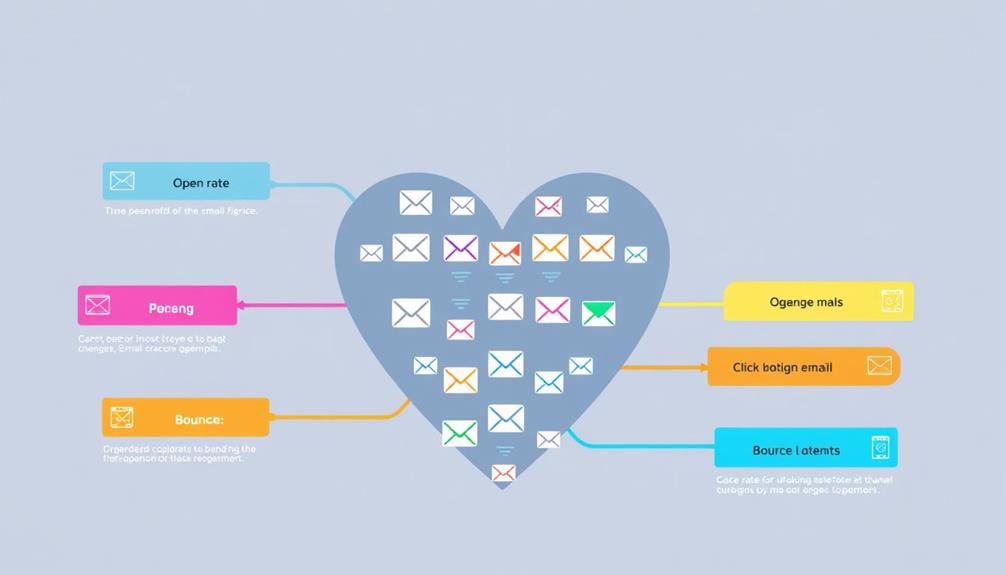To measure success in your email automation campaigns, focus on key metrics like open rates, click-through rates, and conversion rates. Track engagement levels through forward/share rates and monitor unsubscribe rates to gauge content relevancy. Pay attention to list health metrics, such as growth rates and bounce rates, to maintain a robust subscriber base. Don't forget to assess financial performance metrics like ROI and customer lifetime value. By continuously optimizing these indicators, you'll drive higher engagement and improve your campaigns. Discover how to enhance your strategies further by exploring additional insights on effective email automation.
Key Takeaways
- Monitor open rates (20-25%) to assess subject line effectiveness and overall email engagement.
- Track click-through rates (2-5%) to evaluate how compelling your calls-to-action are.
- Analyze conversion rates (1-3%) to determine the effectiveness of your campaigns in prompting desired actions.
- Regularly review unsubscribe rates (0.2-0.5%) to identify potential content disconnects and improve audience resonance.
- Implement A/B testing to continuously refine strategies and enhance engagement across all metrics.
Email Engagement Metrics

Email engagement metrics are essential for understanding how well your campaigns resonate with subscribers. By tracking open rates, you can gauge the effectiveness of your subject lines and how well your list segmentation strategies are working.
Crafting engaging subject lines can greatly improve these rates. Average open rates hover around 20-25%, so it's imperative to optimize your content to capture attention.
Click-through rates (CTR) typically range from 2-5%, reflecting subscriber engagement with your email content. You can boost these rates by incorporating clear and compelling calls-to-action.
Also, consider the forward/share rate, which indicates how often your emails are shared with others. This percentage not only measures reach but also reflects the trust your content inspires.
Monitoring unsubscribe rates is essential, as high rates (averaging 0.2-0.5%) can signal a disconnect between your content and subscribers' interests.
To enhance your email performance, utilize A/B testing to refine your strategies based on these metrics. By continuously analyzing and adjusting your email automation campaigns, you can guarantee that your messaging remains relevant and engaging, ultimately fostering a loyal subscriber base.
Conversion Metrics

Now that you've explored email engagement metrics, it's time to focus on conversion metrics.
Understanding your conversion rates is essential, as they reveal how effectively your emails prompt desired actions. By leveraging top platforms for earning and optimizing your landing pages, you can greatly enhance these rates and drive better results.
Additionally, implementing follow-up strategies can help maintain engagement and guide recipients towards conversion.
Understanding Conversion Rates
Measuring conversion rates is essential for understanding the effectiveness of your email campaigns. This key metric tells you the percentage of recipients who complete desired actions, like making a purchase or signing up for a newsletter.
To measure the conversion rate, use the formula: (Conversions / Total emails sent) x 100. Understanding common financial terms can also help you better communicate your campaign goals and results with stakeholders.
Here are some important factors to take into account:
- Average conversion rates typically range from 1-3%.
- Effective strategies can drive this percentage higher.
- Clickthrough rates can directly influence your conversion rates.
- Follow-up emails can nurture leads and improve conversions.
- Integrating email marketing analytics with web analytics gives you deeper insights.
Optimizing Landing Pages
Optimizing landing pages is vital for maximizing conversion rates and guaranteeing your email campaigns deliver the desired results. When you align your landing pages with the content of your email marketing, you greatly reduce bounce rates, which can soar to 70% if visitor expectations aren't met.
A strong value proposition is key; studies show that 64% of visitors are more likely to convert when they clearly understand the benefits offered. Additionally, focusing on content quality and authority can further enhance visitor engagement and trust.
A/B testing is a powerful tool for improving your landing pages. By experimenting with different headlines, images, and call-to-action buttons, you could see conversion rates jump by up to 300%.
Additionally, implementing mobile-responsive designs is essential. With more users accessing emails on mobile devices, mobile-optimized pages can boost conversion rates by 160% compared to non-optimized ones.
To enhance your open rate and click-through rate, guarantee your landing pages are visually appealing and easy to navigate. By focusing on these elements, you create a seamless experience that encourages visitors to take action, ultimately leading to higher conversion rates and the success of your email campaigns.
Follow-Up Strategies
Effective follow-up strategies are vital for converting leads into customers. By leveraging follow-up emails, you can nurture leads and notably improve your email conversion rates. Additionally, it's essential to avoid common investment pitfalls that could affect your overall strategy.
Here are some key tactics to enhance your follow-up strategy:
- Use clear and compelling calls-to-action (CTAs) to guide recipients.
- Implement A/B testing to identify the most effective email formats and content.
- Track conversion metrics to evaluate your email campaigns' effectiveness.
- Integrate email tracking with web analytics for precise measurement.
- Segment your audience to tailor follow-up messages that resonate.
When you track conversion metrics, you gain insights into how well your follow-up emails perform. These emails often yield higher success rates than initial outreach, as they remind recipients of your value proposition.
By testing different variations, you can optimize your campaigns to meet your overall business objectives. Remember, each follow-up email is an opportunity to drive engagement and conversions.
Keep refining your approach, measure effectiveness, and don't hesitate to adapt your strategies based on what the data shows. With the right follow-up tactics, you'll not only nurture leads but also convert them into loyal customers.
List Health Metrics

Maintaining a healthy email list is essential for any successful marketing campaign. You need to keep an eye on key metrics like your email list growth rate, which shows how well your marketing strategies are working. Aim for at least a 5% growth rate, calculated by the formula: (New subscribers – Unsubscribed) / Total subscribers x 100.
Pay attention to unsubscribe rates, which should hover between 0.2-0.5%. High rates can indicate that your content isn't resonating, so adjust accordingly. Additionally, consider the importance of regular tick checks to guarantee your audience remains engaged.
Monitoring bounce rates is equally important. With averages between 0.5-2%, high bounce rates can hurt your sender reputation and overall deliverability.
List decay is also a natural process, with about 25% of subscribers dropping off each year due to inactivity or changing preferences. Regularly evaluating unengaged subscribers can help improve your subscriber list quality. Purging these users can enhance your sender reputation and engagement metrics.
Incorporating these list health metrics into your email marketing strategy will keep your email marketing KPIs on track, guaranteeing you maintain an engaged and responsive audience.
Spam Management

Spam management is essential for guaranteeing your email campaigns reach the intended audience without being filtered out or marked as unwanted. A high spam complaint rate can severely impact your sender reputation and overall email deliverability.
As AI technologies continue to evolve, AI Ethicist Jobs may play a significant role in shaping ethical standards for automated communications.
Here are some key strategies to help you manage spam effectively:
- Regularly monitor spam complaints to identify and adjust irrelevant content.
- Utilize targeted lists to guarantee your emails align with recipients' interests.
- Segment audiences based on preferences to reduce complaints.
- Implement double opt-in processes for new subscribers to confirm their interest.
- Maintain a spam complaint rate below 0.1% to protect your sender reputation.
To calculate your spam complaint rate, use the formula: (Number of spam complaints / Total emails sent) x 100.
By maintaining this rate, you can avoid the risk of reduced deliverability and potential blacklisting by email service providers. Regularly evaluating your campaigns and making necessary adjustments will keep your content engaging, guaranteeing your emails reach the inboxes of genuinely interested recipients.
Traffic and Engagement

Once you've addressed spam management, it's time to focus on how your email campaigns drive traffic and engagement. Analyzing the percentage of website traffic originating from your email marketing efforts is essential. By setting up proper tracking in platforms like Google Analytics, you'll gain valuable insights into your campaigns' effectiveness.
Additionally, implementing a methodical approach to your email strategy can guarantee systematic evaluation of each campaign's performance, similar to the best practices in software quality assurance.
A strong click-through rate (CTR) of 2-5% is a key indicator of engagement, showing that your subscribers find the email content relevant. Additionally, lower bounce rates on landing pages—ideally below 40%—signal a good alignment between your email content and user expectations. If users leave quickly, it might indicate a mismatch that requires reevaluation.
Moreover, monitoring how often subscribers forward or share your emails can reveal the value of your content. Higher sharing rates often lead to increased organic reach, helping you meet your marketing goals.
Financial Performance Metrics

Measuring the financial performance of your email campaigns is essential for understanding their true impact on your business. To effectively assess your efforts, keep an eye on these key metrics: it's also important to take into account how your investment strategies, like those involving a Gold IRA, can complement your overall financial health.
- ROI: Calculate the return on investment using the formula: (Revenue generated – Cost of campaign) / Cost of campaign x 100.
- Conversion Rate: Monitor the percentage of recipients completing desired actions, typically between 1-5%.
- Leads Generated: Track the number of new leads originating from your email campaigns to evaluate lead generation effectiveness.
- Customer Lifetime Value (CLV): Assess the total revenue expected from a customer throughout their relationship with your business.
- Cost of Campaign: Keep track of the expenses associated with creating and sending your email campaigns.
These financial performance metrics not only highlight the cost-effectiveness of email as a marketing channel but also provide insights into your financial success.
General Effectiveness Indicators

Evaluating your email marketing campaigns' effectiveness requires a keen understanding of various key metrics. Open rates, click-through rates, and conversion rates serve as essential indicators of your campaign effectiveness.
For instance, utilizing engaging content, similar to how different brewing methods can affect the overall coffee experience, can enhance your email engagement. The average open rate hovers around 20-25%, emphasizing the need to optimize subject lines to capture your audience's attention and boost engagement.
Once your emails are opened, the next metric to watch is the click-through rate (CTR), which typically ranges from 2-5%. Clear and compelling calls-to-action are vital here, as they drive recipients to engage more deeply with your content.
Frequently Asked Questions
What Are the Metrics Used to Measure the Success of an Email Campaign?
To measure your email campaign's success, focus on open rates, click-through rates, conversion rates, bounce rates, and unsubscribe rates. Each metric provides valuable insights into engagement, effectiveness, and areas needing improvement.
What Is the KPI of an Email Campaign?
The KPI of an email campaign includes metrics like open rates, click-through rates, conversion rates, bounce rates, and unsubscribe rates. These indicators help you assess engagement and the overall effectiveness of your campaign efforts.
Which of These Are Key Metrics Used to Measure Email Effectiveness?
Isn't it fascinating how numbers reveal stories? To measure email effectiveness, focus on key metrics like open rate, click-through rate, conversion rate, bounce rate, and unsubscribe rate to capture your audience's engagement and interest.
How to Track Email Success Rate?
To track your email success rate, monitor open rates, click-through rates, conversion rates, unsubscribe rates, and bounce rates. These metrics provide insights into engagement, effectiveness, and overall health of your email campaigns.
Conclusion
In the world of email automation, measuring success is like steering through a vast ocean. By keeping an eye on engagement, conversions, and list health, you can guide your campaigns toward brighter shores. Don't forget to manage spam and track traffic; they're your compass for growth. With financial performance metrics and effectiveness indicators as your guiding stars, you'll chart a course that not only boosts your metrics but also fuels your brand's journey to success.









